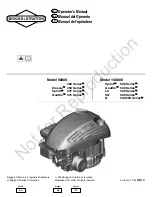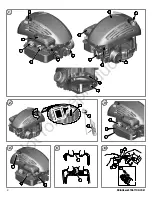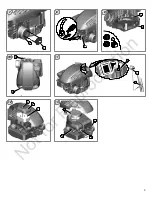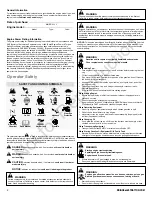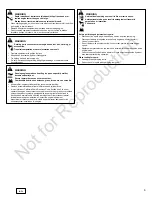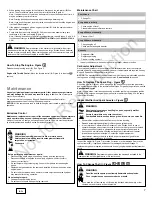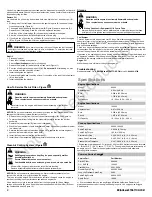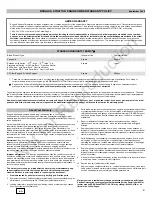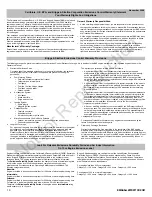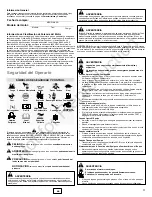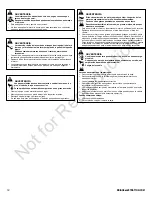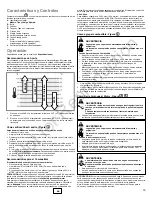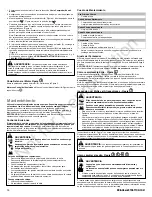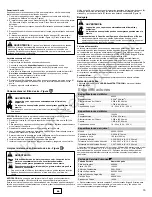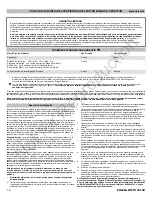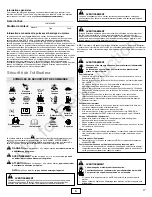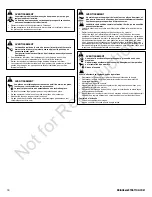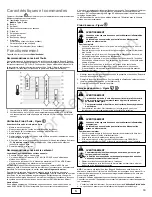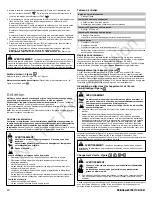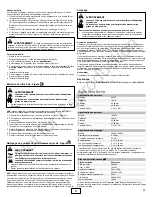
7
en
4. When starting a new engine for the first time, firmly push the red primer (
B
) five
times. Then for all future starts, push the primer three times (Figure 4).
Note:
If engine runs out of fuel or has been stored for an extended period of time, it
may be necessary to prime 5 times.
Note:
Priming is usually unnecessary when restarting a warm engine.
Note:
If you push the primer too many times, excessive fuel will flood the engine and
it will be difficult to start.
5. If the product is equipped with an engine stop lever (
C
), hold the engine stop lever
against the handle (Figure 5).
6. Firmly hold the starter cord handle (
D
). Pull the starter cord handle slowly until
resistance is felt, then pull rapidly (Figure 4).
Note:
If the engine does not start after repeated attempts, repeat Steps 4, 5, and 6. If
it still does not start, go to
BRIGGSandSTRATTON.COM
or call
1-800-233-3723
(in
USA).
WARNING:
Rapid retraction of the starter cord (kickback) will pull your
hand and arm toward the engine faster than you can let go. Broken bones, fractures,
bruises or sprains could result. When starting engine, pull the starter cord slowly until
resistance is felt and then pull rapidly to avoid kickback.
How To Stop The Engine -
Figure
5
Release the engine stop lever (
E
)
.
See Figure 5.
or
Engine with Throttle Control:
Move the throttle control (
A
, Figure 4) to the stop
position.
Maintenance
Use only original equipment replacement parts. Other parts may not perform as
well, may damage the unit, and may result in injury.
In addition, use of other parts
may void your warranty.
We recommend that you see any Briggs & Stratton Authorized Dealer for all
maintenance and service of the engine and engine parts.
NOTICE:
All the components used to build this engine must remain in place for proper
operation.
Emissions Control
Maintenance, replacement, or repair of the emissions control devices and systems
may be performed by any non-road engine repair establishment or individual.
However, to obtain “no charge” emissions control service, the work must be performed
by a factory authorized dealer. See the Emissions Warranty.
Unintentional sparking can result in fire or electric shock.
Unintentional start-up can result in entanglement, traumatic
amputation, or laceration.
Fire hazard
WARNING
Before performing adjustments or repairs:
•
Disconnect the spark plug wire and keep it away from the spark plug.
•
Disconnect battery at negative terminal (only engines with electric start.)
•
Use only correct tools.
•
Do not tamper with governor spring, links or other parts to increase engine
speed.
•
Replacement parts must be the same and installed in the same position as the
original parts.
•
Do not strike the flywheel with a hammer or hard object because the flywheel
may later shatter during operation.
When testing for spark:
•
Use approved spark plug tester.
•
Do not check for spark with spark plug removed.
Maintenance Chart
First 5 Hours
•
Change Oil
Every 8 Hours or Daily
•
Check engine oil level
•
Clean area around muffler and controls
Every 25 Hours or Annually
•
Clean air filter
*
Every 50 Hours or Annually
•
Change engine oil
•
Check muffler and spark arrester
Annually
•
Replace air filter
•
Replace spark plug
•
Clean air cooling system
*
*
In dusty conditions or when airborne debris is present, clean more often.
Carburetor Adjustment
Never make adjustments to the carburetor. The carburetor was set at the factory to
operate efficiently under most conditions. However, if adjustments are required, see any
Briggs & Stratton Authorized Dealer for service.
NOTICE:
The manufacturer of the equipment on which this engine is installed specifies
the top speed at which the engine will be operated.
Do not exceed
this speed.
How To Replace The Spark Plug -
Figure
6
Check the gap (
A
, Figure 6) with a wire gauge (
B
). If necessary, reset the gap. Install
and tighten the spark plug to the recommended torque. For gap setting or torque, see the
Specifications
section.
Note:
In some areas, local law requires using a resistor spark plug to suppress ignition
signals. If this engine was originally equipped with a resistor spark plug, use the same
type for replacement.
Inspect Muffler And Spark Arrester -
Figure
7
Running engines produce heat. Engine parts, especially muffler,
become extremely hot.
Severe thermal burns can occur on contact.
Combustible debris, such as leaves, grass, brush, etc. can catch fire.
WARNING
•
Allow muffler, engine cylinder and fins to cool before touching.
•
Remove accumulated debris from muffler area and cylinder area.
•
It is a violation of California Public Resource Code, Section 4442, to use or
operate the engine on any forest-covered, brush-covered, or grass-covered land
unless the exhaust system is equipped with a spark arrester, as defined in
Section 4442, maintained in effective working order. Other states or federal
jurisdictions may have similar laws. Contact the original equipment
manufacturer, retailer, or dealer to obtain a spark arrester designed for the
exhaust system installed on this engine.
Inspect the muffler (
A
, Figure 7) for cracks, corrosion, or other damage. Remove the
spark arrester (
B
), if equipped, and inspect for damage or carbon blockage. If
replacement parts are required, make sure to use only original equipment replacement
parts.
WARNING:
Replacement parts must be the same and installed in the
same position as the original parts or fire could result.
How To Change The Oil -
Figure
8
9
10 11
WARNING
Gasoline and its vapors are extremely flammable and explosive.
Fire or explosion can cause severe burns or death.
•
If you drain the oil from the top oil fill tube, the fuel tank must be empty or fuel
can leak out and result in a fire or explosion.
Not for Reproduction

